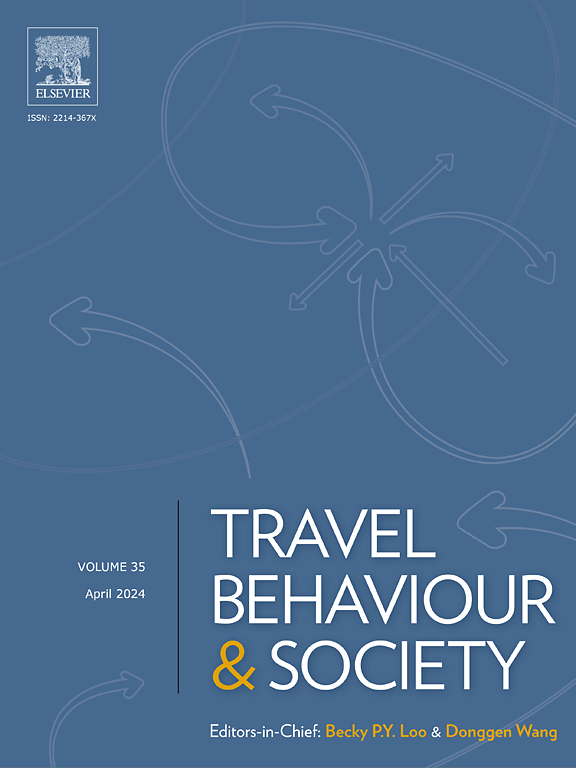A hierarchical Wi-Fi log data processing framework for human mobility analysis in multiple real-world communities
IF 5.1
2区 工程技术
Q1 TRANSPORTATION
引用次数: 0
Abstract
Wi-Fi log data, including communication actions between clients and Access Points (APs), can be used to infer human movement and travel activity and thus would serve as a reliable data source for human mobility analysis. As more and more modern cities or communities provide public free Wi-Fi services, a vast amount of public Wi-Fi log data will be collected and have the potential to be used to characterize human travel patterns and thus develop more effective urban transportation management strategies. However, Wi-Fi log data processing is not trivial. Wi-Fi networks established by various internet equipment manufacturers and devices have different network settings and log file formats. Additionally, the complexity of Wi-Fi log data, along with the ping-pong phenomenon and invalid messages, can result in analysis bias and errors. Though previous studies have processed the specific Wi-Fi log data individually in different ways, a common framework that can address public Wi-Fi data from different locations is needed to improve data processing efficiency and analysis effectiveness. This study proposed a hierarchical and general Wi-Fi data processing and analysis framework to extract client travel activities from Wi-Fi log data. Wi-Fi log data collected from three communities in North Carolina- one university campus, the city of Wilson, and the town of Holly Springs, were processed and analyzed. Based on that, travel activities across different communities with specific Wi-Fi networks could be compared and analyzed to provide community human mobility and travel activity insights and the correlation between human travel and Wi-Fi network features.
一个分层Wi-Fi日志数据处理框架,用于多个现实世界社区的人类移动性分析
Wi-Fi日志数据,包括客户端和接入点(ap)之间的通信行为,可用于推断人类的移动和旅行活动,因此可作为人类移动分析的可靠数据源。随着越来越多的现代城市或社区提供公共免费Wi-Fi服务,大量的公共Wi-Fi日志数据将被收集,并有可能用于表征人类出行模式,从而制定更有效的城市交通管理策略。然而,Wi-Fi日志数据的处理并非微不足道。不同的互联网设备制造商和设备建立的Wi-Fi网络具有不同的网络设置和日志文件格式。此外,Wi-Fi日志数据的复杂性以及乒乓现象和无效消息可能导致分析偏差和错误。虽然以前的研究以不同的方式单独处理特定的Wi-Fi日志数据,但需要一个可以处理来自不同位置的公共Wi-Fi数据的通用框架,以提高数据处理效率和分析效果。本研究提出了一种分层通用的Wi-Fi数据处理和分析框架,从Wi-Fi日志数据中提取客户的旅行活动。从北卡罗莱纳州的三个社区——一个大学校园、威尔逊市和霍利斯普林斯镇——收集的Wi-Fi日志数据进行了处理和分析。在此基础上,通过对具有特定Wi-Fi网络的不同社区的出行活动进行对比分析,提供社区人类流动性和出行活动洞察,以及人类出行与Wi-Fi网络特征之间的相关性。
本文章由计算机程序翻译,如有差异,请以英文原文为准。
求助全文
约1分钟内获得全文
求助全文
来源期刊

Travel Behaviour and Society
TRANSPORTATION-
CiteScore
9.80
自引率
7.70%
发文量
109
期刊介绍:
Travel Behaviour and Society is an interdisciplinary journal publishing high-quality original papers which report leading edge research in theories, methodologies and applications concerning transportation issues and challenges which involve the social and spatial dimensions. In particular, it provides a discussion forum for major research in travel behaviour, transportation infrastructure, transportation and environmental issues, mobility and social sustainability, transportation geographic information systems (TGIS), transportation and quality of life, transportation data collection and analysis, etc.
 求助内容:
求助内容: 应助结果提醒方式:
应助结果提醒方式:


